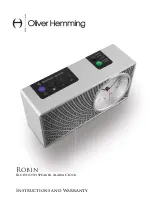
P/N 3101069-EN • REV 005 • ISS 19OCT20
5 / 6
Figure 7: Air pressure differential
(1) Airflow
(2) Sampling tube
(3) HVAC duct
(4) Exhaust tube opening
(5) Air pressure differential
meter
(6) Sampling tube opening
Testing the duct smoke detector
After completing installation of the duct smoke detector, test the
detector to ensure it is operating correctly prior to leaving the site. For
details, refer to Application Bulletin P/N 3101107.
Maintenance
Replacement parts
The following table lists the replacement parts for the duct smoke
detector.
Table 5: Replacement parts
Model
Description
FX-SDPCB
PCB replacement kit for duct smoke detector
Cleaning the duct smoke detector
Clean the duct smoke detector when it becomes 80% to 99% dirty or
sooner if conditions warrant.
Caution:
Before cleaning the duct smoke detector, notify the proper
authorities that the fire alarm system is undergoing maintenance and
take steps to prevent the control panel from responding to a false
alarm.
To clean the duct smoke detector:
1. Disable the detector or zone to prevent false alarms.
2. Remove the detector’s cover, and then power down the detector
by disconnecting the SLC wiring. See Figure 6.
3. Using a vacuum cleaner, clean compressed air, or a soft bristle
brush, remove loose dirt and debris from inside the detector
housing and cover.
4. Remove dirt and other contaminants from the gasket on the
detector’s cover using isopropyl alcohol and a lint-free cloth.
5. Squeeze the retainer clips on both sides of the optic housing then
lift the housing away from the printed circuit board. See Figure 8.
6. Gently remove dirt and debris from around the optic plate and
inside the optic housing.
7. Replace the optic housing and the detector cover, and then
connect the SLC wiring.
8. Test the detector and verify its sensitivity. For details, refer to
Application Bulletin P/N 3101107.
Figure 8: Duct detector cleaning
(1) Sampling tube
(2) HVAC duct
(3) Detector housing
(4) Optic plate
(5) Retainer clip
(6) Optic housing
(7) Airflow
Specifications
Communication line voltage
20 Vp-p max.
Operating current
Normal
Alarm
Inrush
45 µA
45 µA
1 mA
Common alarm relay/auxiliary
equipment
Quantity
Type
Rating
Unsupervised and power-limited
1
Form C
2.0 A at 30 VDC (resistive)
Air velocity
100 to 4,000 ft./min
Air pressure differential
0.005 to 1.00 in. of water
Smoke sensitivity range
0.79 to 2.46%/ft. obscuration
Smoke detection method
Photoelectric (light scattering
principle)
Alarm test response time
5 seconds
Dimensions
8.70 × 5.45 × 1.90 in.
Wire size
14 to 22 AWG wire
Operating environment
Temperature
Relative humidity
32 to 122°F (0 to 50°C)
0 to 93%, noncondensing
Accessories
SD-TRM
SD-TRK
SD-MAG
SD-VTK
R-LED
Remote test-reset station, magnetic
Remote test-reset station, keyed
Test magnet kit
Air velocity test kit
Remote LED alarm indicator
(1)
(2)
(3)
(4)
(5)
(6)
(1)
(2)
(3)
(4)
(5)
(6)
(7)
firealarmresources.com
























